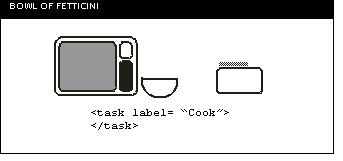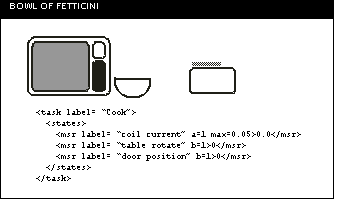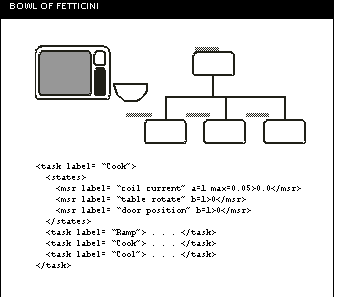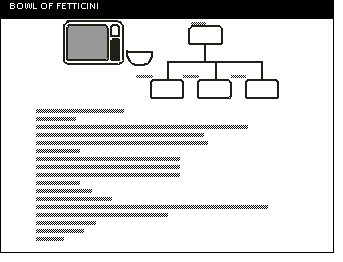Control
Some
objects are active. By active we mean they perform
some operation on the physical world. For example,
an oven heats, a refrigerator cools, a lamp lights
and a saw cuts. All of these objects perform some
operation on other objects.
Active
objects are, for the most part, controlled by humans
- either directly through manual interaction (such
as a hand drill) or indirectly through simple programming
(such as a microwave oven).
A
unique capability of the intelligent infrastructure,
is the ability of objects to communicate with each
other. A bottle, for example, can "talk to"
a refrigerator to tell it that its there and what
it contains. Food can inform the oven to tell it how
it to cook. In short, objects can control machines
instead of the other way around.
A
classic example is the bowl of fetticini (a passive
object) that "communicates" its cooking
instructions to a microwave (an active object) - all
without human intervention.
We
can use our infrastructure to communication, but what
gets communicated? We need some control language that
active objects understand and that passive objects
can store and communicate.
We
generally refer to this type of language as a
task-level control
language, in that it executes
tasks - that is discrete, high-level functions
- and control in that it
actively regulates and response to objects and their
environment.
In
the following sections, we outline the design and
specification of a task-level control language. We
begin by using the planning and scheduling definition
of the previous chapter as a starting point in the
design of this specification.
Task
We
begin with a fundamental element called a
task .
<task>
. . . </task>
The
task includes an administrative
information, which records general management information,
such as author, owner and manager. The
task element includes a list of
states that describe the fundamental parameters
of the task.
The
task also contains a set of
functions that determine its operation. These
functions include a context
function that ensures appropriate execution, an
update function that recalculates the state parameters,
an action function that
sends commands directly to actuators (such as motors,
switches, relays, solenoids, etc.) and a
goal function that determines the successful
completion of a task.
Name
Each
task has a name specified as an argument to a
label attributed.
<task
lable= name > . . .
</task>
This
name is importance. It is used to identify the task
to the task interpretation and management software.

Administration
The
first element is an administrative element that
includes information about authorship, management,
ownership, etc. Task management may be distributed
across the network, so that even simple administration,
such as `who wrote this code' and `whom do I call
when the code fails,' becomes difficult. The administration
or admin element facilitates
software management. The admin
element includes one or more entity
elements that contain this information.
<task>
<admin>
<entity> . . . </entity>
. . .
<entity> . . . </entity>
</admin>
</task>
We
may also want to include general descriptions of
a task and how it performs. Therefore, we also include
one or more present elements
within the admin element to
describe and explain the particular task.
<task>
<admin>
<entity> . . . </entity>
. . .
<entity> . . . </entity>
<present> . . . </present>
. . .
<present> . . . </present>
</admin>
</task>
States
There
are certain fundamental parameters that describe
an object, such as the temperature of a refrigerator,
the current in a heating coil or position of the
washer door. We call these fundamental parameters
states .
Some
states, such as the temperature, cannot be controlled,
they are simply measured. Others are under direct
control, such as current in a heating coil or switch
in a relay. We bundle these in an element called
states .
The
states element includes one
or more measurement or msr
elements, each signifying a parameter, name, offset,
units and accuracy.
<states>
<msr label= string
> offset </msr>
State 1
<msr label= string
> offset </msr>
State 2
. . .
<msr label= string
> offset </msr>
State n
</states>
The
label attribute is used to
identify the state within the task, the value of
the measurement provides the offset, the attributes
( m, kg, s, a, K, cd, mol, q, rad
and p ) define the units and
the min and
max attributes define the accuracy or tolerance.
Implicit
states
In
addition to the state list given above, we also
include a set of implicit states.
We
include a global date specified, in accordance with
the PML date definition, in milliseconds from Midnight
Janurary 1 1970 GMT . This time may be accessed
within the functions that make up the task function
definition. It is refered to simply as
date .
A
second implicit state is the total execution time
of a task. The execution time state records the
total length of time a task has been running. This
state is given the name time.
The variable time is measured
in milliseconds (in accordance with the PML specification)
and may be reset at the discretion of control code.
Finally,
every task has access to the activity of every other
task using a state value nameActive,
where name is the name
of the task. The variable nameActive
holds a boolean value that is true
when the task is active and false
otherwise.
All
of the implicit states ( date, time
and nameActive ) are automatically available within
any function.

Subtasks
Many
tasks can be broken up into subtasks - or "steps"
in a process. Mowing the lawn, for example, involves
opening the garage door, removing the mower, starting
the motor, pushing the mower, etc. When the bag
fills, stopping the motor, removing the bag and
emptying the contents.
We
wish to reflect this observation in the task definition
by allowing one or more subtasks
- or simply tasks - within the
task element.
<task>
. . .
<task> . . . </task>
. . .
<task> . . . </task>
</task>
Since
the task element can contain another task element,
we define a hierarchical structure of tasks and
subtasks, as shown in .


Function
A
task definition requires of a set of functions.
These functions are algorithms that control and
monitor a task. Since these functions required generic
control instructions, we need a software control
language or access to a server running a software
control language.
We
will address these issues with a
function element.
<function> . . . </function>
The
function element contains
either (1) in-line source code, (2) a reference
source code, (3) a reference a class (i.e. compiled
source code) or (4) a reference to a server process.
In-line
source code
Since
we require general, unrestricted control instructions,
we defer to a well-established programming language
- JAVA [ref]. Therefore we allow the
function element to contain in-line JAVA
source code.
<function>
source code </function>
The
source code here contains a single function that
returns a boolean value
<function>
source code ;
return boolean ;
</function>
This
source code may access any state value of the
task using a Hashtable variable called states.
To reference a particular state, we supply the
states variable with the text string containing
the name of the state and then apply the predefined
value function and cast the returned Object to
the appropriate date type - floating point number
(Float), integer (Integer) or boolean (Boolean).
(
type ) states.get( name
).value();
The
actual code or control instruction is left to
the discretion of the programmer.
Reference
In
addition to in-line source code, the
function also accepts a Universal Resource
Locator reference to the source code. The form
of this source code is identical to that presented
above.
<function>
URL
</function>
Server
We
wish to encourage networked control and distributed
processing, therefore we allow the definition
of a server process. Specifically, we include
optional host and
port elements, which define the host identification
and port number of a server that accepts the task's
state vector and returns the state vector and
a boolean value.
<function>
<host> string
</host>
<port> integer
</host>
</function>
Rate
Each
function element includes a manatory rate element,
which specifies the update period in seconds.
This is the "tick" rate that the function
is executed.
<function>
<rate> float
</rate>
. . .
</function>
The
function element defined
here has its use in the various functions of a
task definition. We outline these task functions
in the next sections.
Task
Control Functions
The
task includes four function: a mandatory
context function that ensures appropriate execution,
a mandatory update function that recalculates the
state parameters, an optional
action function that sends commands directly
to actuators (such as motors, switches, relays,
solenoids, etc.) and a mandatory
goal function that determines the successful
completion of a task.
Context
Function
Not
all tasks are appropriate at all times. A microwave
oven, for example, should not operate if there
is nothing in it, nor should a washer wash if
the door is open.
A
task should not execuite if it is not our desire
We don't want the air-conditioner to run in the
winter nor the heater in the summer.
Finally,
a task should not execute if it is already complete.
We don't need the oven to cook the food if it
is already cooked.
The
proper conditions for task execution we will simply
call the context .
If the context is right; that is if the user wants
it and the conditions are acceptable, the task
will execute.
We
define a context element
that contains a function the operates on the set
of states defined by the state
element.
<context>
<function>
<rate> . . . </rate>
source code ;
return boolean ;
</function>
</contex>
If
the context function returns
true , the task executes
and if not the task (and all subordinate tasks)
suspend immediately.
In
this sense, a subtask is "never on its own."
Tasks are never allowed to operate unless they
have been explicitly permitted to do so by their
superiors.
Within
every active task, the context
function operates continuously
. In other words, even if a task spawns a series
of subtask (and these subtask and so on), the
original task does not stop running the
context function.
If
the context function of
any task returns false ,
all subordiante tasks
suspend, as shown in Figure
1, If the context function of any function returns
false all subordinate tasks suspend execution..
In this way, the task system never operates inappropriately.

The
purpose of the context function is to ensure reliable
operation and to gaurantee failure detection,
fault tolerance and recovery functions are embedded
into the task hierarchy.

Update
Function
The
next function is a mandatory
update function. This function simply updates
the state vector according to the rate specified
by the rate element.
Goal
Function
The
mandatory goal function
returns true when all the
conditions for successful task execution have
been satisfied.
Action
Function
At
some point it is necessary to actually control
a device. The optional action
function sends control commands to actuators -
motors, solenoids, switches, etc. - that actually
effect the physical world.
By
its definition, tasks that contain an
action function are leaf tasks in the task
tree; that is, they are the lowest level tasks
in the task hierarchy.
Specification:
Control
<task
label= string >
<admin>
<entity> . . . </entity>
. . .
<entity> . . . </entity>
<present> . . . </present>
. . .
<present> . . . </present>
</admin>
<states>
<msr label= string
> offset </msr>
State 1
<msr label= string
> offset </msr>
State 2
. . .
<msr label= string
> offset </msr>
State n
</states>
</task>
<context>
<function> <rate>
float </rate>
source code ;
return boolean ;
</function>
</contex>
<update>
<function> <rate>
float </rate>
source code ;
return boolean ;
</function>
</update>
<goal>
<function> <rate>
float </rate>
source code ;
return boolean ;
</function>
</goal>
<action>
<function> <rate>
float </rate>
source code ;
return boolean ;
</function>
</action>
<task>
. . . </task>
. . .
<task>
. . . </task>
</task>



